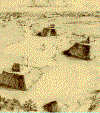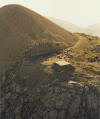|
Gympie
The town of Gympie, at Tin Can Bay, north of Brisbane,
Queensland, is the unlikely site of a pyramid complex. The first
Europeans to come into the area in the 1830's learned of them
from the now extinct Kabi speaking people of Gympie, known then
as the Dhamuri.
According to the Aboriginals, brown skinned,
blue eyed, blond haired beings with Dolphin pendants came from
the star Orion and built the pyramids and temple sites, but
water came in and destroyed it all long ago. The ruins were
taboo to them.
Settlers took the stones of the pyramids and other buildings and
used them as foundation stones for the main street of Gympie and
the construction of buildings, including the local church, which
still stands. There were stone statues like the Easter Island
statues and also animal statues. These have since been destroyed
or are hidden, but photos and sketches of them remain from the
first white man to come into the area. Even the tunnels under
Gympie were dynamited.
All but one of the Pyramids were bulldozed into the ocean by the
army in the 1950's and the lone survivor remains on private land
with a strict "no trespassing policy".
The Pyramid is 100 foot
high and designed with a series of terraces up to 4 feet tall
and eight feet wide. The army sealed the entrance in the 1930's
after investigating reports of cattle wandering into the pyramid,
when an opening was still accessible, and never coming out. No
reports or findings are available. In recent years, according to
locals, the owner has attempted to destroy the pyramid in the
hopes of discouraging visitors to the site.
Artifacts have
survived including the 'Gympie Ape', which was dug up in 1966
and is thought to be a statue of the Egyptian God Horus, who was
often portrayed as an ape, and another resembling Ganesha from
Indian mythology.
|
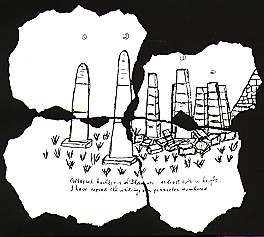
Artist's
Rendering Gympie Petroglyph |
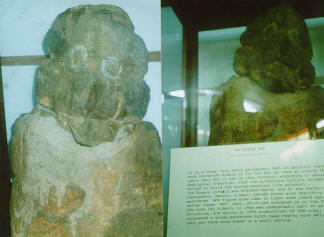
The Gympie Ape |
Central Coast
A pyramid structure, at least twice the height and dimensions of
the Gympie example, has been found near the NSW Central Coast.
New Guinea
Five pyramids, identical to the Gympie Structure, have been
found in northeastern New Guinea
Magnetic Island
There is a pyramid on Magnetic Island and a sphinx.
Legend of Gympie and the
Gympie Pyramid
from
CrystaLinks Website
The
Gympie Pyramid located in
the outskirts of
Gympie in Queensland,
Australia is a terraced structure that some claim was built
by ancient Egyptians long before Europeans came to
Australia, while others say it was built by an Italian
vineyard owner in the 1950s.
Constructed from granite blocks, it stands about 100 feet
tall. A small idol was allegedly dug up around the same area
that some say is a representation of the Egyptian god Thoth
in ape form clutching the Tau or the Cross of Life. This
statue is now on display in the Gympie Museum.
According to Rex Gilroy, the man who discovered the pyramid
and who runs the museum, it was created by Egyptians who had
mining operations in Australia centuries ago, with bases of
operation reaching as far as the Blue Mountains in New South
Wales.
Other objects
have been purportedly found in the area including scarabs,
coins and even an Easter Island type head.
The town of Gympie, at Tin Can Bay, north of Brisbane,
Queensland, is the unlikely site of a pyramid complex.
The first Europeans to come into the area in the 1830's learned
of them from the now extinct Kabi speaking people of Gympie,
known then as
the Dhamuri. According to the
Aboriginals, brown skinned, blue eyed, blond haired beings
wearing dolphin pendants came from
Orion long ago and built
pyramids and temple sites, but water covered them all.
The ruins were taboo to them. Settlers took the stones of the
pyramids and other buildings and used them as foundation stones
for the main street of Gympie and the construction of buildings,
including the local church, which still stands. There were stone
statues like the Easter Island statues and also animal statues.
These have since been destroyed or are hidden, but photos and
sketches of them remain from the first white man to come into
the area. Even the tunnels under Gympie were dynamited.
All but one of the Pyramids was bulldozed into the ocean by the
army in the 1950's and the lone survivor remains on private land
with a strict "no trespassing policy.
The Pyramid is 100 foot high and designed with a series of
terraces up to 4 feet tall and eight feet wide.
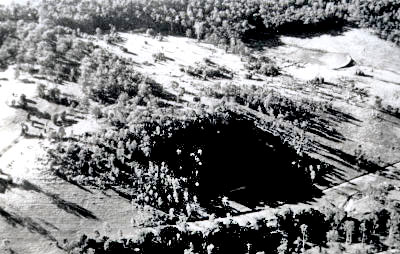
The Gympie Pyramid
Note the causeway that extends from left of picture.
A stone wharf once stood at the southern base [in from the
road],
the pyramid being on the edge of the former harbor.
Rex Gilroy 2004
The army sealed the entrance in the 1930's after investigating
reports of cattle wandering into the pyramid, when an opening
was still accessible, and never coming out. No reports or
findings are available.
In recent years, according to locals, the owner has attempted to
destroy the pyramid in the hopes of discouraging visitors to the
site.
Artifacts have survived including the 'Gympie Ape', which was
dug up in 1966 and is thought to be a statue of the Egyptian God
Thoth, who was often portrayed as an ape, and another resembling
Ganesha from Indian mythology.
Egyptian God Thoth is clutching the Tau or the Cross of Life.
This statuette is badly weathered with age. Thoth was the god of
writing and wisdom, depicted as an ape by the Egyptians until
about 1000 BC when he became an Ibis-headed human bodied deity
who recorded the judgment of the souls of Amenti, the after
world. Thoth's symbol was the papyrus flower.
All of this is speculation.
Back to Pyramidal Constructions in The
World
Back to Australia - Continent of Contrasts |






